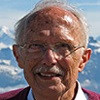5.7.1: A Mix of Science and Astrology
- Page ID
- 5998
Overview
Predicting the future does not sit well with most earthquake scientists, including Charles Richter, quoted above. Yet if earthquake research is to truly benefit society, it must lead ultimately to prediction, no matter how elusive that goal may be.
Society asks specialists to predict many things, not just earthquakes. How will the stock market perform? Will next year be a good crop year? Will peace be achieved in the Middle East? The answers to any of these important questions, including the chance of a damaging earthquake near you in the near future, depend on the complex bits of information. For each question, experts are asked to predict outcomes, and their opinions often are in conflict. Mathematicians tell me that predicting earthquakes and predicting the behavior of the stock market have a lot in common, even though one is based on physical processes in the Earth, and the other is not.
But earthquake prediction carries with it a whiff of sorcery and black magic, of ladies with long dangling earrings in dark tents reading the palm of your hand. Geologists and seismologists involved in earthquake prediction research find themselves sharing the media spotlight with trendy astrologers, some with business cards, armed with maps and star charts. I heard about one woman on the Oregon coast who claims to become so ill before natural disasters—that have included major California earthquakes and the eruption of Mt. St. Helens—that she has to be hospitalized. After the disaster, she recovers dramatically. Jerry Hurley, a high-school math teacher in Fortuna, California, would get migraine headaches and a feeling of dread before an earthquake. His symptoms were worst when he faced in the direction of the impending earthquake. Hurley is a member of MENSA, the organization for people with high IQ, and he would just as soon somebody else had this supposed “talent.”
Some of these people claim that their predictions have been ignored by those in authority, especially the USGS, which has the legal responsibility to advise the president of the United States on earthquake prediction. They go directly to the media, and the media see a big story.
A self-styled climatologist named Iben Browning forecast a disastrous earthquake on December 3, 1990, in the small town of New Madrid, Missouri. The forecast was picked up by the media, even after a panel of experts, the National Earthquake Prediction Evaluation Council (NEPEC), had thoroughly reviewed Browning’s prediction and had concluded in October of that year that the prediction had no scientific basis. By rejecting Browning’s prediction, the nay-saying NEPEC scientists inadvertently built up the story. Browning, who held a Ph.D. degree in zoology from the University of Texas, had based his prediction on a supposed 179-year tidal cycle that would reach its culmination on December 3, exactly 179 years after a series of earthquakes with magnitudes close to 8 had struck the region. His prediction had been made in a business newsletter that he published with his daughter and in lectures to business groups around the country. Needless to say, he sold lots of newsletters.
Despite the rejection of his prediction by the seismological establishment, Browning got plenty of attention, including an interview on Good Morning America. As the time for the predicted earthquake approached, more than thirty television and radio vans with reporting crews descended on New Madrid. The school was let out, and the annual Christmas parade was canceled. Earthquake T-shirts sold well, and the Sandywood Baptist Church in Sikeston, Mo., announced an Earthquake Survival Revival.
The date of the earthquake came and went. Nothing happened. The reporters and TV crews packed up and went home, leaving the residents of New Madrid to pick up the pieces of their lives. Browning instantly changed from earthquake expert to earthquake quack, and he became a broken man. He died a few months later.
The USGS once funded a project to evaluate every nonscientific forecast it could find, including strange behavior of animals before earthquakes, to check out the possibility that some people or animals could sense a premonitory change not measured by existing instruments. Preliminary findings indicated no statistical correlation whatsoever between human forecasts or animal behavior and actual events. The project was aborted for fear that it might earn the Golden Fleece Award of then-Senator William Proxmire of Wisconsin for the month’s most ridiculous government waste of taxpayers’ money


